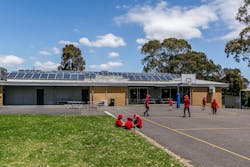Many communities in Australia hit by bushfires, floods, unreliable electricity and extended power outages are looking into community microgrids, but a number of obstacles stand in the way, according to a report by two researchers from the Institute for Sustainable Futures at the University of Technology Sydney.
The researchers interviewed community members who had proposed 25 of the 36 projects funded by a $50.4 million grant program from the Australian government’s Regional and Remote Communities Reliability Fund (RRCRF) for microgrid feasibility studies in over 110 communities across Australia.
25 projects in 78 communities studied
The 25 projects studied by the Institute for Sustainable Futures were located in 78 of the 110 communities, said Scott Dwyer, research director for the institute.
Dwyer, working with Ph.D. student Farzan Tahir, found that most of the communities were seeking to deploy microgrids to provide resilience.
For example, in the wake of bushfires in 2019, one town in Queensland lost power for days and telecommunication, transportation and sewage systems were destroyed, prompting residents to seek the funding.
Bushfires and heavy storms are challenges to resilience
“The main drivers for that particular microgrid were the bushfires at the end of 2019 and early 2020, where half of the community was basically burnt down. And a lot of the properties around the surrounding area were destroyed,” said the researchers’ report.
Another interviewee from a rural community in Victoria affected by heavy storms in June 2020 said that the resulting power, internet and communication outages prompted a need to find solutions.
“This has led to the broad reflection from actors, including local community organizations, on the need to rethink the local energy systems when sections of their community are made to go without power for one to two weeks,” said the report.
National policy framework missing, report said
The report found that a number of barriers stand in the way of community microgrid deployment including:
- A need for a policy and regulatory framework.
- The need to keep community members engaged.
- Difficulty bridging the gap between feasibility studies and deployment.
- Difficulty developing business models.
The lack of a trained workforce was also a challenge, said Dwyer.
On the policy side, Australia needs an overarching federal strategy, he said.
Workforce development, community leaders needed
“We’re saying we need something that is more holistic, whether for a microgrid or a neighborhood battery, something needs to tie all this together to help communities be more resilient and have reliable energy,” said Dwyer. The holistic solution might include programs to promote skills and workforce development. In rural areas, it's hard to find electricians, people to lead community engagement efforts and collect data. And, in some areas, the internet isn’t reliable.
These needs intensify in remote regions, said Dwyer.
“Most interviewees stated a lack of a clear regulatory framework around microgrids as the main barrier in their respective projects,” said the report. “The regulatory framework in Australia varies by state, making it challenging to regulate uniformly at the federal level.”
One interviewee said that this makes it difficult for microgrid proponents to move through the usual steps of design, development, signing a revenue contract and then connecting customers.
Residents don’t want third parties controlling their batteries
Developing business models was also a hurdle to the communities seeking microgrids. For some projects including energy storage as part of a proposed microgrid created tension and divided some in the community, said the report. Some residents didn’t want to offer control of their battery systems to a third party. Another person interviewed said that his project lacked a clear business model that could provide both affordable electricity for consumers and benefits for the utility.
Lack of funding, access to capital, high upfront capital costs and the difficulty of finding financing were also obstacles, along with attracting investments from third parties. Most of the projects funded by the government in small remote communities that needed 1 MW to 2 MW of solar and 2 MWh to 3 MWh of storage found small returns compared to the capital needed to install and operate the microgrids.
In the social arena, the study found that lack of trust and energy literacy were roadblocks, along with community burnout.
“A low level of trust existed between local communities and the energy retailers and energy network providers,” said the report.
Volunteer burnout a problem
And community members experienced volunteer fatigue, said Dwyer.
Many of the feasibility studies were conducted by volunteers who worked for a number of years engaging community members.
“The result is that some individuals from the community can get frustrated with continually contributing their time without seeing any positive outcomes or change,” said the report.
That was true of seniors in Oakmont, California, who have put on hold plans to develop a community microgrid in part because one person – Ken Smith, who invested 900 hours of volunteer time – was leading the effort, and he felt like the project wasn’t moving forward.
In Australia, community leaders in remote communities tend to change roles often, which also slows movement on projects, the report said.
Additional funding sources in Australia for remote microgrids
The feasibility study grants aren’t the only programs that aim to deploy microgrids in remote communities.
In August 2023, the Australian Renewable Energy Agency began accepting applications for its Regional Microgrids Program, which aims to develop and deploy microgrids in regional and remote communities.
In addition, Australian utility Horizon Power operates 34 microgrids to help it supply 100,000 residents and 10,000 businesses in towns and remote communities.
As remote and rural communities struggle with energy resilience, the RRCRF funding could be helpful, said the report. But much needed is a national policy framework for microgrids that can improve resilience and costs in communities.
“A coordinated and multifaceted approach is essential to ensure that communities in rural and remote areas genuinely reap the benefits of microgrids,” said the report.
The Microgrid 2024 Conference is Focused on the DER Revolution
April 22-24 in Baltimore at the Waterfront
Mission Critical is the Aim: Communities, Public Service, Universities and more
Early Bird Registration is $365 off Regular Price before March 18








